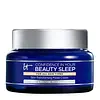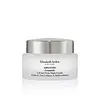What's inside
What's inside
 Key Ingredients
Key Ingredients

 Benefits
Benefits

 Concerns
Concerns

 Ingredients Side-by-side
Ingredients Side-by-side

Water
Skin ConditioningDimethicone
EmollientGlycerin
HumectantSimmondsia Chinensis Seed Oil
EmollientHydrogenated Castor Oil Dimer Dilinoleate
Skin ConditioningPropanediol
SolventAlcohol Denat.
AntimicrobialCaprylic/Capric Triglyceride
MaskingCetyl Alcohol
EmollientCetyl Hydroxyethylcellulose
Emulsion StabilisingOctyldodecanol
EmollientSilica
AbrasivePhenoxyethanol
PreservativeAlbizia Julibrissin Bark Extract
MaskingCaprylyl Glycol
EmollientParfum
MaskingPoloxamer 338
EmulsifyingCapryloyl Salicylic Acid
ExfoliatingLimonene
PerfumingAdenosine
Skin ConditioningTocopherol
AntioxidantXanthan Gum
EmulsifyingDisodium EDTA
Linalool
PerfumingCeramide NP
Skin ConditioningHydroxypalmitoyl Sphinganine
Skin ConditioningSilica Dimethyl Silylate
EmollientHydrated Silica
AbrasiveSodium Hyaluronate
HumectantPolysorbate 60
EmulsifyingCitronellol
PerfumingSodium Benzoate
MaskingCI 16035
Cosmetic ColorantGeraniol
PerfumingCereus Grandiflorus Flower Extract
Skin ConditioningCitral
PerfumingDarutoside
Skin ConditioningCI 42090
Cosmetic ColorantGlucose
HumectantLactic Acid
BufferingPotassium Sorbate
PreservativeWater, Dimethicone, Glycerin, Simmondsia Chinensis Seed Oil, Hydrogenated Castor Oil Dimer Dilinoleate, Propanediol, Alcohol Denat., Caprylic/Capric Triglyceride, Cetyl Alcohol, Cetyl Hydroxyethylcellulose, Octyldodecanol, Silica, Phenoxyethanol, Albizia Julibrissin Bark Extract, Caprylyl Glycol, Parfum, Poloxamer 338, Capryloyl Salicylic Acid, Limonene, Adenosine, Tocopherol, Xanthan Gum, Disodium EDTA, Linalool, Ceramide NP, Hydroxypalmitoyl Sphinganine, Silica Dimethyl Silylate, Hydrated Silica, Sodium Hyaluronate, Polysorbate 60, Citronellol, Sodium Benzoate, CI 16035, Geraniol, Cereus Grandiflorus Flower Extract, Citral, Darutoside, CI 42090, Glucose, Lactic Acid, Potassium Sorbate
Water
Skin ConditioningDimethicone
EmollientGlycerin
HumectantButylene Glycol
HumectantCetearyl Alcohol
EmollientIsostearyl Alcohol
EmollientCaprylic/Capric Triglyceride
MaskingCeteth-20 Phosphate
CleansingButylene Glycol Cocoate
EmulsifyingPolymethylsilsesquioxane
Ammonium Acryloyldimethyltaurate/Vp Copolymer
Acetyl Tetrapeptide-11
Skin ConditioningAcetyl Tetrapeptide-9
Skin ConditioningAmylopectin
Butyrospermum Parkii Butter
Skin ConditioningCaprylyl Glycol
EmollientCarbomer
Emulsion StabilisingCeramide AP
Skin ConditioningCeramide EOP
Skin ConditioningCeramide NP
Skin ConditioningCeteth-20
CleansingCholesterol
EmollientDicetyl Phosphate
EmulsifyingDimethyl Isosorbide
SolventDisodium EDTA
Ethylcellulose
Hydroxyethyl Acrylate/Sodium Acryloyldimethyl Taurate Copolymer
Emulsion StabilisingIsohexadecane
EmollientLauryl PEG-9 Polydimethylsiloxyethyl Dimethicone
Skin ConditioningLeontopodium Alpinum Callus Culture Extract
AntioxidantLithothamnion Calcareum Extract
Skin ConditioningMaris Sal
Skin ConditioningPEG-100 Stearate
PEG-40 Hydrogenated Castor Oil
EmulsifyingPentylene Glycol
Skin ConditioningPhytosphingosine
Skin ConditioningPolysorbate 20
EmulsifyingPolysorbate 60
EmulsifyingSodium Carrageenan
Emulsion StabilisingSodium Lauroyl Lactylate
EmulsifyingTheobroma Cacao Seed Butter
EmollientTocopheryl Acetate
AntioxidantTromethamine
BufferingXanthan Gum
EmulsifyingParfum
MaskingPhenoxyethanol
PreservativeWater, Dimethicone, Glycerin, Butylene Glycol, Cetearyl Alcohol, Isostearyl Alcohol, Caprylic/Capric Triglyceride, Ceteth-20 Phosphate, Butylene Glycol Cocoate, Polymethylsilsesquioxane, Ammonium Acryloyldimethyltaurate/Vp Copolymer, Acetyl Tetrapeptide-11, Acetyl Tetrapeptide-9, Amylopectin, Butyrospermum Parkii Butter, Caprylyl Glycol, Carbomer, Ceramide AP, Ceramide EOP, Ceramide NP, Ceteth-20, Cholesterol, Dicetyl Phosphate, Dimethyl Isosorbide, Disodium EDTA, Ethylcellulose, Hydroxyethyl Acrylate/Sodium Acryloyldimethyl Taurate Copolymer, Isohexadecane, Lauryl PEG-9 Polydimethylsiloxyethyl Dimethicone, Leontopodium Alpinum Callus Culture Extract, Lithothamnion Calcareum Extract, Maris Sal, PEG-100 Stearate, PEG-40 Hydrogenated Castor Oil, Pentylene Glycol, Phytosphingosine, Polysorbate 20, Polysorbate 60, Sodium Carrageenan, Sodium Lauroyl Lactylate, Theobroma Cacao Seed Butter, Tocopheryl Acetate, Tromethamine, Xanthan Gum, Parfum, Phenoxyethanol
 Reviews
Reviews

Ingredients Explained
These ingredients are found in both products.
Ingredients higher up in an ingredient list are typically present in a larger amount.
This ingredient is an emollient, solvent, and texture enhancer. It is considered a skin-softener by helping the skin prevent moisture loss.
It helps thicken a product's formula and makes it easier to spread by dissolving clumping compounds.
Caprylic Triglyceride is made by combining glycerin with coconut oil, forming a clear liquid.
While there is an assumption Caprylic Triglyceride can clog pores due to it being derived from coconut oil, there is no research supporting this.
Learn more about Caprylic/Capric TriglycerideCaprylyl Glycol is a humectant and emollient, meaning it attracts and preserves moisture.
It is a common ingredient in many products, especially those designed to hydrate skin. The primary benefits are retaining moisture, skin softening, and promoting a healthy skin barrier.
Though Caprylyl Glycol is an alcohol derived from fatty acids, it is not the kind that can dry out skin.
This ingredient is also used as a preservative to extend the life of products. It has slight antimicrobial properties.
Learn more about Caprylyl GlycolCeramide NP is a type of ceramide.
Ceramides are intercellular lipids naturally found in our skin that bonds dead skin cells together to create a barrier. They are known for their ability to hold water and thus are a great ingredient for dry skin.
Ceramides are an important building block for our skin barrier. A stronger barrier helps the skin look more firm and hydrated. By bolstering the skin ceramides act as a barrier against irritating ingredients. This can help with inflammation as well.
If you would like to eat ceramides, sweet potatoes contain a small amount.
Read more about other common types of ceramides here:
Ceramide AP
Ceramide EOP
Dimethicone is a type of synthetic silicone created from natural materials such as quartz.
What it does:
Dimethicone comes in different viscosities:
Depending on the viscosity, dimethicone has different properties.
Ingredients lists don't always show which type is used, so we recommend reaching out to the brand if you have questions about the viscosity.
This ingredient is unlikely to cause irritation because it does not get absorbed into skin. However, people with silicone allergies should be careful about using this ingredient.
Note: Dimethicone may contribute to pilling. This is because it is not oil or water soluble, so pilling may occur when layered with products. When mixed with heavy oils in a formula, the outcome is also quite greasy.
Learn more about DimethiconeDisodium EDTA plays a role in making products more stable by aiding other preservatives.
It is a chelating agent, meaning it neutralizes metal ions that may be found in a product.
Disodium EDTA is a salt of edetic acid and is found to be safe in cosmetic ingredients.
Learn more about Disodium EDTAGlycerin is already naturally found in your skin. It helps moisturize and protect your skin.
A study from 2016 found glycerin to be more effective as a humectant than AHAs and hyaluronic acid.
As a humectant, it helps the skin stay hydrated by pulling moisture to your skin. The low molecular weight of glycerin allows it to pull moisture into the deeper layers of your skin.
Hydrated skin improves your skin barrier; Your skin barrier helps protect against irritants and bacteria.
Glycerin has also been found to have antimicrobial and antiviral properties. Due to these properties, glycerin is often used in wound and burn treatments.
In cosmetics, glycerin is usually derived from plants such as soybean or palm. However, it can also be sourced from animals, such as tallow or animal fat.
This ingredient is organic, colorless, odorless, and non-toxic.
Glycerin is the name for this ingredient in American English. British English uses Glycerol/Glycerine.
Learn more about GlycerinParfum is a catch-all term for an ingredient or more that is used to give a scent to products.
Also called "fragrance", this ingredient can be a blend of hundreds of chemicals or plant oils. This means every product with "fragrance" or "parfum" in the ingredients list is a different mixture.
For instance, Habanolide is a proprietary trade name for a specific aroma chemical. When used as a fragrance ingredient in cosmetics, most aroma chemicals fall under the broad labeling category of “FRAGRANCE” or “PARFUM” according to EU and US regulations.
The term 'parfum' or 'fragrance' is not regulated in many countries. In many cases, it is up to the brand to define this term.
For instance, many brands choose to label themselves as "fragrance-free" because they are not using synthetic fragrances. However, their products may still contain ingredients such as essential oils that are considered a fragrance by INCI standards.
One example is Calendula flower extract. Calendula is an essential oil that still imparts a scent or 'fragrance'.
Depending on the blend, the ingredients in the mixture can cause allergies and sensitivities on the skin. Some ingredients that are known EU allergens include linalool and citronellol.
Parfum can also be used to mask or cover an unpleasant scent.
The bottom line is: not all fragrances/parfum/ingredients are created equally. If you are worried about fragrances, we recommend taking a closer look at an ingredient. And of course, we always recommend speaking with a professional.
Learn more about ParfumPhenoxyethanol is a preservative that has germicide, antimicrobial, and aromatic properties. Studies show that phenoxyethanol can prevent microbial growth. By itself, it has a scent that is similar to that of a rose.
It's often used in formulations along with Caprylyl Glycol to preserve the shelf life of products.
Polysorbate 60 is used to help stabilize products. It is a surfactant and emulsifier. These properties help keep ingredients together in a product. Surfactants help reduce surface tension between ingredients with different states, such as liquids and solids. Emulsifiers help prevent oils and waters from separating.
Polysorbate 60 is sorbitol-based and created from the ethoxylation of sorbitan. Ethoxylation is a chemical reaction used to add ethylene oxide. Sorbitan is a the dehydrated version of sorbitol, a sugar found in fruits.
In this case, the 60 comes from reacting 60 units of ethylene oxide with sorbitan.
Polysorbates are commonly used in medicine and foods.
Learn more about Polysorbate 60Water. It's the most common cosmetic ingredient of all. You'll usually see it at the top of ingredient lists, meaning that it makes up the largest part of the product.
So why is it so popular? Water most often acts as a solvent - this means that it helps dissolve other ingredients into the formulation.
You'll also recognize water as that liquid we all need to stay alive. If you see this, drink a glass of water. Stay hydrated!
Learn more about WaterXanthan gum is used as a stabilizer and thickener within cosmetic products. It helps give products a sticky, thick feeling - preventing them from being too runny.
On the technical side of things, xanthan gum is a polysaccharide - a combination consisting of multiple sugar molecules bonded together.
Xanthan gum is a pretty common and great ingredient. It is a natural, non-toxic, non-irritating ingredient that is also commonly used in food products.
Learn more about Xanthan Gum